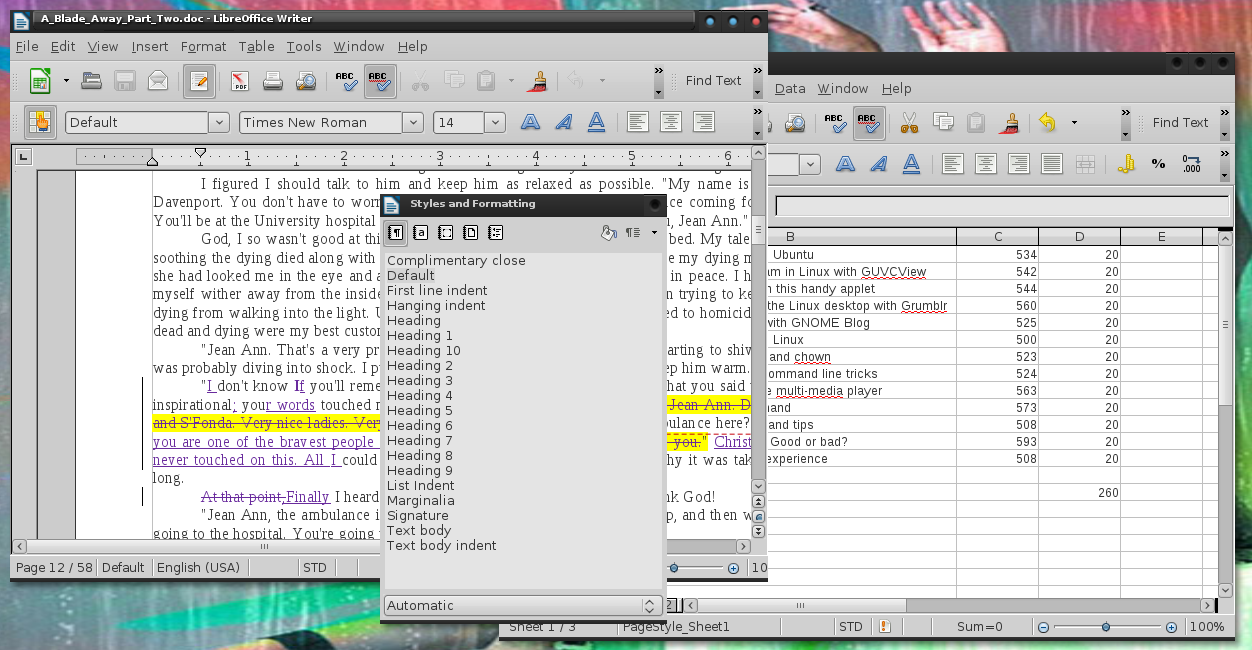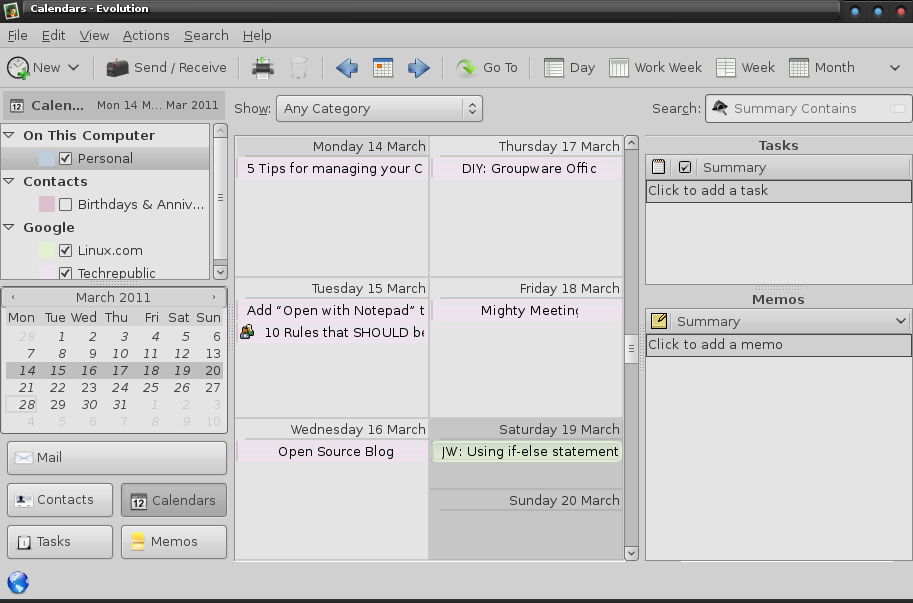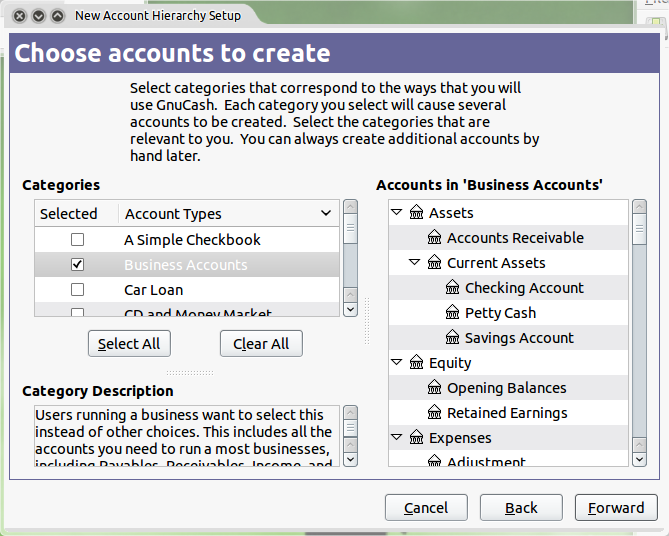The business office is where the Linux desktop should reign. Why? Linux is a reliable, stable, secure solution that would have any business user working day-in and day-out without fail. With an unheard of resistance to viruses, trojans, and worms, the office user enjoying the Linux desktop would have no concerns about down time as does the average Windows user. But what tools are there available for the usual office worker? Plenty!
With a nod toward what the usual business day looks like, I have assembled what I think to be the five must-have office tools for the Linux desktop. With this collection of tools, most office workers could get the overwhelming majority of their work done. The only tool I have left off of this list is the Web browser, as it is a tool everyone knows of and is included in every Linux distribution.
You will find that many of these tools are not included with the average Linux desktop. The good news is that they are all just a couple of clicks away, using the distribution’s Add/Remove Software tool. So, with that piece of advice out of the way, let’s get on with the software!
Office Compatibility with LibreOffice
 I have to start with the most obvious tool first. LibreOffice is a fork of OpenOffice and is bound to become the King of the Linux desktop office tools. This piece of software offers everything anyone needs from an office suite: Word Processor, Spreadsheet, Presentations, Database, Drawing tool, and Math Formula tool. LibreOffice also is one of the most versatile office suites, when it comes to inter-operation with other office suites (LibreOffice is compatible with all major office suites.) LibreOffice also offers a feature you won’t find in the likes of MS Office — extensions. With extensions you can extend the capabilities of this FOSS office suite well beyond the norm. A sample list of extensions include: PDF import, Report Builder, Non-linear Solver, Wiki Publisher, and more. Check out the LibrePlanet wiki for more extensions. Figure 1 shows the main LibreOffice interface, where each of the applications can be launched.
I have to start with the most obvious tool first. LibreOffice is a fork of OpenOffice and is bound to become the King of the Linux desktop office tools. This piece of software offers everything anyone needs from an office suite: Word Processor, Spreadsheet, Presentations, Database, Drawing tool, and Math Formula tool. LibreOffice also is one of the most versatile office suites, when it comes to inter-operation with other office suites (LibreOffice is compatible with all major office suites.) LibreOffice also offers a feature you won’t find in the likes of MS Office — extensions. With extensions you can extend the capabilities of this FOSS office suite well beyond the norm. A sample list of extensions include: PDF import, Report Builder, Non-linear Solver, Wiki Publisher, and more. Check out the LibrePlanet wiki for more extensions. Figure 1 shows the main LibreOffice interface, where each of the applications can be launched.
Manage Money with GnuCash
If you are looking for a replacement for the costly, often buggy accounting package you’ve been using, look no further than GnuCash. This double-entry accounting tool is filled with outstanding features that can do everything from:
- Produce highly detailed reports
- Handle on-line banking
- Manage stocks and bonds portfolios
- Manage customers and vendors
- Handle multiple currencies
- QIF/OFX import
- Statement reconciliation
- Powerful search tool
- Check printing
- And much, much more
And what’s best about GnuCash is you won’t find it randomly crashing on you, demanding you switch to single-user mode, bringing your desktop to a crawl, or losing precious data. And although GnuCash does not currently offer a client/server mode, it is a feature that is being considered for future releases.
One of the most powerful features you will find in GnuCash is its reporting capabilities. From within the Reports menu, the following reports can be created:
- Advanced Portfolio
- Asset Piechart
- Average Balance
- Balance Sheet
- General Journal
- General ledger
- Liability Piechart
- Net Worth Barchart
- Customer Report
- Easy Invoice
- Employee Report
- Payable Aging
- Receivable Aging
- Vendor Report
- Budget Report
- Cash Flow
- Expense Barchart
- Income Statement
- Transaction Report
- And much more
Figure 2 shows the Account creation wizard for creating a Business account in GnuCash.
As you can see, GnuCash creates most of the standard accounts required for Business use.
Desktop Publishing with Scribus
Scribus is one of those tools that is often overlooked and under-appreciated. Scribus is, at it’s heart, an incredibly powerful desktop publishing tool capable of handling nearly any task usually handled by far costlier tools. Scribs brings to the Linux desktop powerful page layout similar to that of PageMaker and QuarkXPress. And Scribus isn’t just for office fliers, party brochures, and resumes. Scribus can be used to create full-color, full length books, texts, and more! Scribus offers the power of:
- Color separations
- CMYK
- Spot Color Support
- ICC Color Management
- High-quality, versatile (RIP-ready) PDF creation
- Layer support
- Transparency support
- And much more
With Scribus anyone can create anything from brochures to full-length, print-quality books. And with a very user-friendly interface, the learning curve is not nearly as steep as that of either PageMaker or QuarkXPress. Figure 3 illustrates the simple user interface offered in Scribus.
When Scribus is started it allows for the creation of various types of new files, or the opening of existing documents.
XSane: Full-Featured Scanning on Linux
XSane, a graphical frontend for SANE. Although there are far easier scanning tools available (such as Simple Scan), you won’t find many scanning tools with the power and flexibility of XSane. XSane offers the following features:
- Color Management
- Filters
- OCR Scanning
- Slide and film scanning
- Fax support
- Email support
- Enhancement
- Histogram
- Batch scan
- And more
The one issue many users might have with XSane is the interface, as XSane borrows from the The GIMP school of thought and offers a multi-windowed interface (see Figure 4.) Some users will have trouble getting used to this type of interface, but once accustomed to the interface, XSane is quite easy to use.
The XSane interface can be used with only the two main interface windows.
Replace Outlook with Evolution
I almost hesitate to include Evolution in this list, but until a better groupware client becomes available for the Linux desktop, Evolution will remain the de facto standard. Evolution is to Linux what Outlook is to Windows, only without much of the bothersome issues (such as the PST/OST problems that often occur, or the huge hit Outlook can take on your system resources). Evolution even has an interface that will be immediately familiar to plenty of users (see Figure 5). There is plenty to like about Evolution:
- Full desktop integration
- No viruses or worms
- Advanced searching
- User-defined filters
- Multiple calendar views
- Built-in junk filtering
- Web calendar support
- Multiple account support
- Customized reminders
- iCalendar support
- LDAP support
- Built-in security and encryption
 Some users will appreciate that Evolution also has (with the aid of an installable extension) the ability to connect to an Exchange server. Although this feature is still in heavy development, it does work and allows you near-Outlook functionality.
Some users will appreciate that Evolution also has (with the aid of an installable extension) the ability to connect to an Exchange server. Although this feature is still in heavy development, it does work and allows you near-Outlook functionality.
Without the groupware client, the Linux desktop would have a hard time working within an office setting. This is especially true when the business and/or office depends upon non-web-based shared calendaring. Fortunately, the Linux desktop does have Evolution, which is always improving.
The Evolution interface is even laid out similarly to that of Outlook (minus the pesky Ribbon Interface.)
Final Thoughts
There are many nay-sayers out there who believe that Linux is just not ready for the business desktop. But, as you can see, Linux has the basic functionality of the office desktop covered. And until you have seen Linux function in the office, you can not appreciate how efficient, reliable, and user-friendly Linux can be. If a business is looking to cut down on time spent cleaning their desktop PCs from viruses, trojans, worms, registry issues, or any other headaches associated with MS Windows, that business would be smart to give the Linux desktop a try. With the lack of down-time, users will be able to work more efficiently and IT expenses will plummet!








